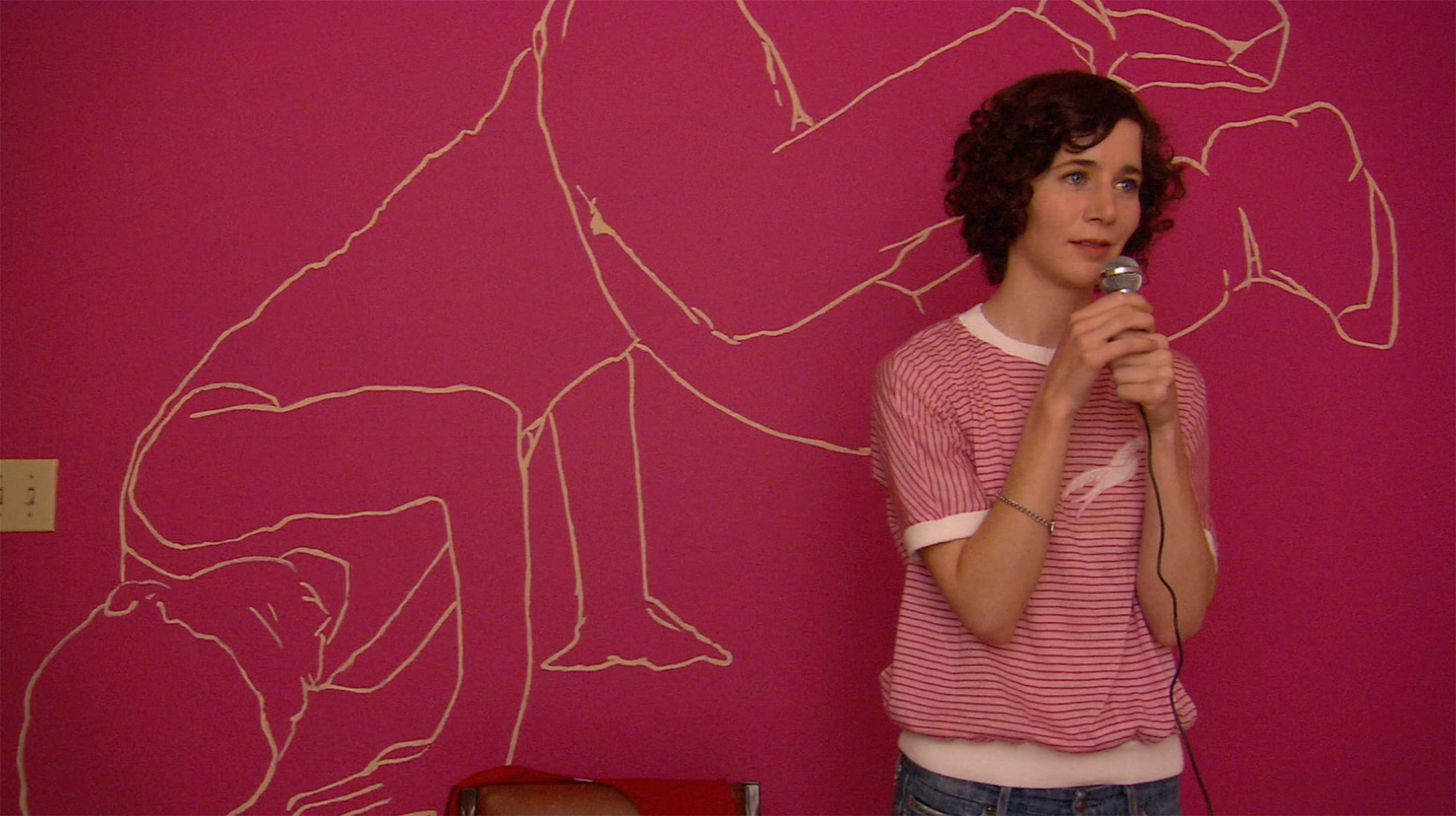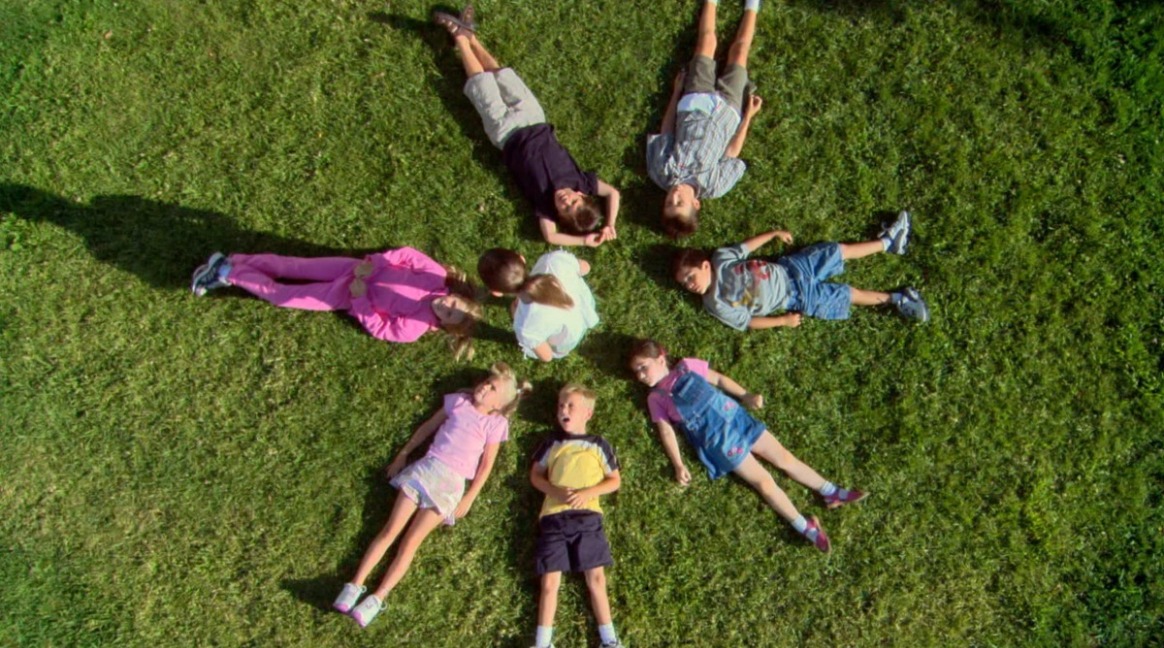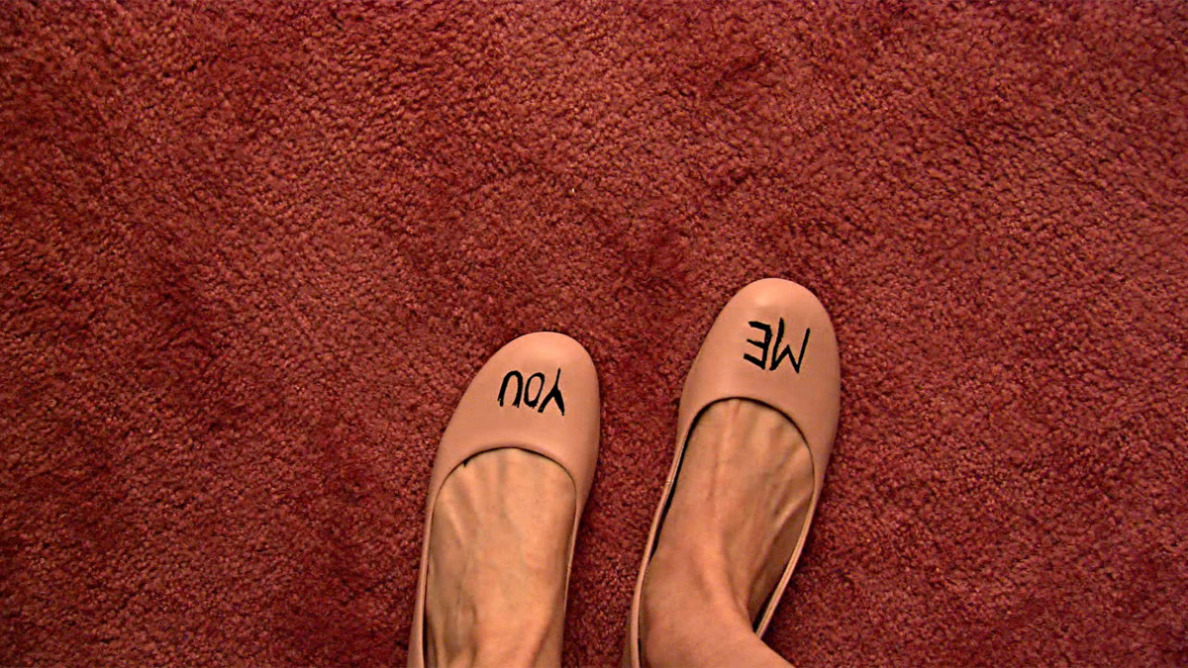RELATED ARTICLE
Building a New World: A Conversation with Miranda July
By Andrew Chan
Me and You and Everyone We Know: Punk Cars Bodies Movies
The Criterion Collection

I first fell in love with Miranda July’s work with her strange, wild, poignant short stories; her stories led me to her novel and first two feature films, which I watch so often that they have over time become spiritual comforts. In late 2019, I was staying in the guesthouse of a Benedictine abbey in wintry Connecticut, feeling like an alien fumbling around on a planet distant from my own. I am not Catholic—I am not even religious—but every day I went to Mass in the morning and vespers at twilight, and during the daylight hours between the services, I worked beside the nuns out in the November cold, splitting wood with sledgehammers and wedges or yanking tomato cages from the beds of dead plants. At night, frozen to my marrow, I fell into my bed to read a book or to rewatch July’s Me and You and Everyone We Know (2005). Maybe it was because the abbey is a place of ritual and song and vast and openhearted generosity—maybe because July, who also acts in the film, has a face with the intense radiance of a medieval saint, all carved ivory and lapis lazuli—but it was only there, surrounded by plainchant and prayers, that I saw for the first time how carefully this astonishing film had been built around the characters’ longing for a sort of radical, near religious, and ungraspable vulnerability.

“In the world of the film, only those at the beginning and end of life inhabit a sort of genuine openness.”
In the world of the film, only those at the beginning and end of life inhabit a sort of genuine openness. The least corrupted soul is the smallest child in the film, six-year-old Robby (Brandon Ratcliff), one of two sons of the shoe salesman Richard (John Hawkes), whom we meet just after he has separated from his wife, Pam. Robby’s still and startled face registers wonder at all the things that happen around him. Christine (July) is an artist who works driving senior citizens around in an “Eldercab,” and two of her clients are the nearly as sweet and open Michael and Ellen, who live in a retirement center called, in a wry touch, Saint Tod’s (tod is “death” in German). Here, in their last years, Michael and Ellen have each discovered that the other is their life’s profoundest love, and though they’re sad about encountering each other so late, this fact doesn’t embitter them. It somehow makes them even softer, gentler. Robby, Michael, and Ellen glow with openness, yet, all around them, the rest of the characters are hapless, a little confused. The others, from young to middle-aged, all fall somewhere on the spectrum of desperation, each attempting to return to a lost vulnerability through the purifying act of performance.
It became clear to me, after this time spent rewatching the film in the nuns’ narrow guest bed, that the audience is being primed to see Me and You and Everyone We Know as a sort of braided fugue of performance from the moment the film opens in Christine’s bedroom, where she is recording on video a still photograph of silhouettes against a sunset, modulating the volume of snow on a television set as background noise, and intoning solemn professions of love in the voices of the characters she is imagining into life. Christine is a performance and video artist, searching and hungry but deeply shy, and each of the pieces she makes in this film is an expression of her own longing for connection.
Her work embraces its own sincerity, its own awkwardness and rough edges. Later, Christine will create a dance of love offered and rejected with a video of her feet in ballet flats that she bought from Richard, with whom she has become romantically obsessed, on which she has written me on the left shoe and you on the right. She will create a piece that finally gets her into the Center for Contemporary Art, a different intonation of love over another filmed still photograph, a work that, though she was adamant about being a solo artist, has finally been sparked to life by the voice of her friend Michael, who by now is grieving the death of Ellen. Christine has opened herself through these performances, made herself vulnerable. Outside of her art, her longing for Richard also manifests itself as an enactment: she returns, again and again, to the department store where he works, to haunt him, to gaze at him from afar, as though playing out her own abjection.

“The recurrent motif of all this longing and vulnerability in the story is the color pink; once you look for pink in the film, you see it everywhere.”
Once you see Christine and Richard in their performances, it’s hard to miss those of the other characters. There is a little girl, Sylvie, who lives next door to Richard, Peter, and Robby. Her enactment is of the domesticity and maternal care that her own mother can’t provide: she feeds smaller neighborhood children gummy worms as if they are baby birds; she buys kitchen equipment and stores it in a hope chest, in a dream of one day being a mother who will treat her own daughter with tenderness. The adolescent Heather and Rebecca are becoming aware of their sexuality and the way that their new womanly bodies give them power over men, and they test this power and their courage by performing an extended flirtation with Andrew, Richard’s doughy, middle-aged coworker and friend. The girls also force themselves to give a blow job to poor Peter, of whom they require an arrangement of washcloths and candies for the experiment as though these items were the tools of a solemn religious ritual. For Andrew’s part, he has been enacting his desire for the girls with pervy signs in his window about their bodies and the sex acts he wants them to do, but he falls to the floor in a panic when they actually knock on his door, understanding in that moment that all along his lust for these underage virgins has been only a display, not an expression of true desire. And, of course, there’s the refracted double performance of Robby and Nancy Herrington, the curator of the Center for Contemporary Art, who engage in weird online chats. Nancy believes she is speaking to an adult; Robby genuinely believes that the most intimate thing in the world is “pooping back and forth, forever.” In her loneliness, Nancy considers this a hilarious and improbable and honestly pretty gross act, and shyly performs her sexual excitement.
The recurrent motif of all this longing and vulnerability in the story is the color pink; once you look for pink in the film, you see it everywhere. Christine’s room, where she makes her art, has an electric-pink wall with a figure drawn on it; her carpet is a dusty pink. She puts hot-pink dots on her dashboard and on the videocassette that she sends to the Center for Contemporary Art for consideration, and gently pushes her longing and hope into the dots with her fingers. The ballet flats she buys from Richard when she meets him are pink, as is the rosebush that Pam’s new boyfriend plants in the place where Richard burned his hand in his catastrophic ritual of reconciliation. All pink: Rebecca’s underpants when she moons Andrew; Sylvie’s house and her backpack and the carpet in her bedroom and the pages of her book of longing; Pam’s shirt when Christine accosts her in a fit of despairing jealousy. The flowers on Nancy’s shirt are the fuchsia of hope when she waits at the park for the adult she thinks she has been sexily chatting with online. There’s a repeated image, near the beginning and end of the film, of a framed photograph of a bird; having become a symbol of love lost and new love born, the image reveals itself, when it is taken outside into the twilight, to be framed in pink.
Most devastatingly, though, at least for me, is the ambiguous pink of the final scene in Me and You and Everyone We Know. It feels prayerful; it feels mysterious, perhaps something like an antiphon sung in Latin in the high, clear voices of nuns. Throughout the film, Robby is awakened early in the mornings by an eerie clacking sound: we watch him struggle to understand what the sound is as, day after day, he wanders around the apartment where his father and brother are sleeping, listening in his sweet and thoughtful wonder. He asks his parents about the noise: Richard is still thinking about the argument he was just having with Pam, so he tells the boy that he should still be asleep in bed. Pam does a little better: she makes something up, telling Robby that it is the sound of streetlights going on and off in the morning. Still, he is unsatisfied. At last, he wanders outside in the grayness before dawn and follows the sound until he discovers that it comes from a man who stands there every day, waiting for a bus, clacking at the pole of a stop sign with a quarter held between his fingers. The man tells the boy that he’s just passing the time. When the bus arrives, he hands Robby the quarter. The sun rises in its hot-pink glory, and Robby takes the man’s place, his face radiant in astonishment, and taps and taps, fervently, as though his tapping alone is the thing heaving the sun up into the sky. This conclusion is like one of July’s perfect short-story endings, and, like the best kind of short-story ending, it can be read in a dozen ways. The way I favor is so bittersweet that it hurts the heart. We don’t see the moment when Robby eventually stops tapping, but we hear the sound of it die away. Perhaps he doesn’t realize it today, but one day he will understand that his rhythmic striking was not what brought the sun out of its sleep; that the sun would have risen and the day begun without his help. And whenever that day comes, Robby will lose the beautiful tenderness of the babyhood he still possesses, and he will fall into confusion like the rest of us, experimenting through desperate performance in an attempt to regain the vulnerability that time stole from him.

Unfolding in elaborately choreographed long takes, this sublime adaptation of László Krasznahorkai’s novel The Melancholy of Resistance captures the weight of time and the mood of fascism with a haunting palpability.

In her first fiction film, director Alice Diop brings the skills of observation she has learned from her documentary work to a thought-provoking exploration of race, power, and motherhood.

In Gus Van Sant’s wickedly funny tale of suburban depravity, Nicole Kidman plays a vacuous weather reporter whose hunger for fame anticipates our own era of digital celebrity.

One of the first postrevolutionary Iranian films screened and celebrated internationally, Amir Naderi’s autobiographical masterpiece is a lyrical exploration of childhood that showcases the director’s gift for radical simplicity.